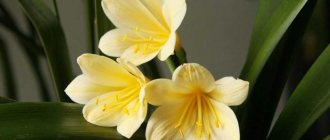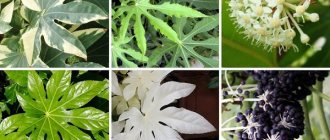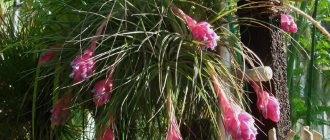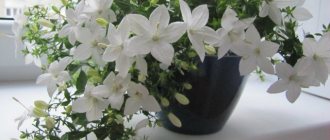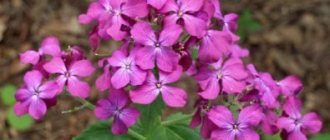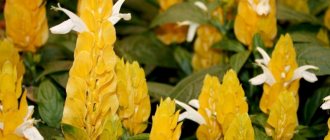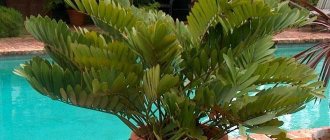- Description of the ctenant
- Types of indoor tenants
- Features of growing ctenanta
- Growing conditions for indoor ctenants
- Caring for a ctenanta at home
- Watering and air humidity
- Lighting and placement
- Temperature and ventilation
- Top dressing and fertilizer composition
- Transplantation, containers and substrate
- Diseases, pests and problems in growing ctenanta
- Reproduction of ctenanta
- Possible difficulties in growing ctenanta
- Video: ktenanta - care/transplantation/reproduction
The tropical rainforests of South America (Brazil and Costa Rica) are the homeland of ctenants, herbaceous perennial plants from the arrowroot family. Ctenanta (often called ctenante) is similar to representatives of two genera of the family - calathea and stromanthus. However, in contrast to them, the ctenantha has solid, asymmetrical, large, oval or oval-elongated leaves (as if collected in a bunch due to short internodes), narrowed towards the base.
Ktenanta Berl-Marx.
Ctenanta is often confused with its relatives - arrowroot and calathea. And not only because of the external similarity, but also often perceiving it as a plant that is identical in care. Despite the relatedness, the ctenantha still differs from other Maranthaceae species. This plant is a true decoration of a modern interior - for experienced gardeners or gardeners who are ready to provide it with careful care. The ideal oval leaves on thin petioles and contrasting, strict patterns make the ctenants look prim and somewhat “cold”. But when used correctly, this disadvantage turns into an advantage.
Variegated ctenanta - for decorating modern interiors.
Description of the ctenant
Representatives of the genus Ctenanthe are modern houseplants in every sense. And it’s not only about the special colors, the strict beauty and elegance of the leaves, flaunting the play of contrasts of dark green with silver or cream tone, but also about the possibilities of using plants.
The genus Ctenantha, or Ctenanthe, has about 15 plant species. These are perennial herbaceous plants. The leaves are linear or oblong-ovate, large, up to 20 cm long, green or multi-colored. The flowers are collected in large spikes.
Ctenanta is a rather demanding plant that suffers greatly from dry air. Don't forget about this if you want to purchase this plant.
Ctenanta, depending on the variety, can reach a height of 60 cm to 1 m. The main advantage of plants of this family is the unusually beautiful, original and very varied in color leaves. Some have a rather strict geometric pattern, rare among plants. On a smooth background from light (almost white) to dark green, triangular, oval spots, stripes, occasionally combined with protruding pink or white veins, stand out effectively. Sometimes the leaves of the ctenantha are so thin that the veins are visible in the light and create an even greater decorative effect.
Oppenheim's ctenanta tricolor.
Ctenants, representing the Marantaceae family , are evergreen stemless perennials that are easily distinguished from their relatives by a limited number of patterns, a more elongated shape of rectangular-oval leaves and petioles that are at least 2 times the height of the calathea.
Despite the sufficient variety of shapes, ctenantha leaves are always easy to recognize - by their absolute flatness, smooth edge and almost perfect symmetry of an elongated oval with an ovoid or almost rectangular base. The leaves are large, from 20 to 40 cm in length, on very high thin petioles.
Ctenanthe burle-marxii.
The leaves unfold from characteristic “tubes”, at night and with strong shading they rise straight up, crackling and making noise, and during the day they fall again, revealing luxurious patterns. Ctenants react very sensitively to light and self-regulate their inclination, protecting themselves from the sun, indicating too high temperatures or lack of moisture - from sticking out with an edge to pressing against the petioles.
The richness of the colors of greenery is a virtue that makes the ctenanta almost an ideal Marant for modern design styles. Decorative, always contrasting, leaves of the ctenantha invite you to admire the contrast of dark green along the edges and veins with a “solid” silver spot between them. The reverse purple side is visible only when raised, but decorates the plant no less.
Ktenanta: description and characteristics of the plant
Indoor flower Ktenanta: photo
The herbaceous perennial ctenanthe, or ctenanthe, is included in the Marantaceae family. The plant grows wild in the humid South American tropics. This genus includes 15 varieties of evergreen vegetation.
The Ktenanta plant can very easily be confused with Calathea, which also belongs to the Maranthaceae family. These flowers are almost identical to each other; scientists disagree on the classification of these plants. The differences between these species lie in the anatomy of the flower, but if you grow them at home, they will bloom quite rarely. When buying ctenanta in a specialized store, you can make a mistake and buy calathea instead of ctenanta, because they are very similar. However, crops belonging to the Marantaceae family need to be cared for in almost the same way.
The Ctenanta flower is valued for its beautiful leaves. The leaves are quite elongated, whole, dark green in color, on the outside there are a large number of stripes that diverge asymmetrically from the vein located in the center to the edge. The stripes may be yellow, pale green, or silver in color.
The leaves of the ctenantha flower are quite mobile. They follow the sun's rays, lowering and rising as they do so. This is such an amazing feature.
The flowers are not decorative. The inflorescence resembles a spike or scallop.
Types of indoor tenants
- Oppenheim's ctenant (Ctenanthe oppenheimiana) is one of the largest and most famous species of ctenant. With a height of up to 1 m, it produces huge oval-elongated leaves up to 40 cm in length, which appear completely flat. An exemplary species with silvery dark green contrasting veins and leaf blades and a dark purple reverse.
- Ctenanthe setosa is a large, meter-long species with narrower stripes, widened leaf bases and densely pubescent petioles.
- Ctenanthe compressa is a medium-sized species, up to 50 cm, with whitish-gray leaves without contrasting dark stripes and an almost rectangular outline.
- Ctenanthe burle- marxii is a beautiful low species up to 40 cm tall with wide, silvery leaves with a blunt tip and very thin stripes.
- Ctenanthe amabilis is a gray-green compact species that forms almost thickets, grows quickly, up to 40 cm in height.
- Ctenanthe lubbersiana has a slightly more restrained growth and height - up to 80 cm, a pale light green underside of the leaves and a creamy yellow-green upper side with predominantly variegated veins and wide white or cream stripes.
- Ctenanthe marantifolia is a more compact golden species with compact, up to 20 cm leaves, with light green and yellow stripes and spots.
Oppenheim's Ctenanthe oppenheimiana.
Ctenanthe marantifolia.
Ctenanthe lubbersiana.
Diseases and pests, control methods
If the growing conditions of the ctenant are not met, insects may appear on its surface and in the soil, causing various plant diseases:
| Disease or pest | How to recognize | Control measures | Prevention |
| Mealybug | The leaves turn pale, fall off, and white fluffy lumps appear in which small insects hide | Remove the pest manually, spray with insecticide | Regular monitoring of the cleanliness of the leaves and stems of the plant, proper care. Careful inspection of the newly acquired plant and its mandatory two-week quarantine (possibly with preventive treatment with an insecticide) to avoid possible infection of all flowers by pests |
| Shchitovka | Dying of leaves, appearance of dark plaques on them | Wash off insects with a damp sponge and soap, treat the plant and soil with an insecticide | |
| Spider mite | The leaves dry out, turn white, and brown spots and cobwebs appear on them. | Wash the flower with a shower, covering the soil with a film, treat with an insecticide until the pest is completely destroyed. | |
| Thrips | Leaves dry out, black spots and small insects appear | Wash the plant and treat with an insecticide until the insects are completely destroyed. | |
| Root system rotting | Leaf wilting in wet soil | Dry the soil, reduce watering or replant the plant and treat it with a root formation stimulator | Select a suitable pot, control the watering schedule, monitor the room temperature |
| Gray mold caused by a fungus | The appearance of dark spots resembling mold on leaves and stems | Remove the affected parts of the flower, replant it in another soil, treating it with a fungicide |
Features of growing ctenanta
Flowering : Ctenantha mainly blooms in summer.
Light : ctenanta prefers bright, diffused light. Should be protected from direct sunlight.
Temperature : in spring and summer 22-25°C, a little cooler at night. In the autumn-winter period, daytime temperatures are within 20°C, at night 16-18°C.
Watering the ctenant : abundantly, as the top layer of the substrate dries. In autumn and winter, watering is slightly reduced.
Air humidity : high. The plant needs regular spraying.
Feeding : from spring to autumn once every 2 weeks with flower fertilizer. In winter, fertilizing is reduced to once every 5-6 weeks. Ctenanta reacts poorly to excess calcium and nitrogen in the soil.
Ctenant pruning : when replanting, remove old dying leaves.
Rest period : not expressed.
Replanting ctenants : young plants annually, adults - once every two to three years in late spring or summer, with fresh soil added annually.
Ctenantha propagation : by dividing the bush and rooting apical cuttings.
Transplant procedure and preparation for it
For females under the age of five years, transplantation is an annual procedure. Adult specimens are moved to a new pot less often - every 2-3 years. At the same time, they change the top 2–3 cm of soil annually. The best time for the procedure is late spring or early summer.
The container is wide and shallow, similar to a bowl. Each time its diameter is increased by 5–7 cm. The best material is unglazed ceramics, in which the soil sours much less often.
The soil required is sufficiently nutritious, but at the same time well-permeable to air and water, and slightly acidic. A special mixture for Marantaceae is rarely found on sale, so it is prepared independently from leaf soil, peat chips, coarse river sand (2:1:1) and pieces of charcoal, finely chopped sphagnum moss (approximately 5% of the total volume of the mixture). An alternative is commercial azalea substrate.
Soil for arrowroot is rarely found on sale, but it can be replaced with a self-prepared mixture, all components of which are quite accessible
The transplant itself looks like this:
- Pour expanded clay or pebbles into the new pot (layer 2–3 cm thick). On top there is about the same amount of fresh soil.
- Remove the ctenanta from the old container. This is easier to do if you water the plant generously about half an hour beforehand. Try to keep the earthen ball intact.
- Trim dried leaves. Do the same with dead and/or rotten roots. Sprinkle the “wounds” with crushed chalk, activated carbon, and cinnamon.
- Place the earthen ball in a new pot, add substrate around the edges. When finished, gently shake the container to fill any voids.
- Do not water the plant for 3-5 days. Take special care to protect it from direct sunlight. This will help minimize the stress experienced.
The plant is replanted by dividing the bush, trying not to destroy the earthen lump.
Video: transplanting plants from the Marantaceae family
Caring for a ctenanta at home
The need to maintain very high air humidity is the most difficult aspect of growing ctenanta. But she doesn’t like mistakes with watering either.
Ctenants are relatively shade-tolerant plants, develop well in diffused light, and love bright, diffused light. In winter, plants also need good lighting. They do not tolerate direct sunlight well during the spring and summer months. The size and color of ctenantha leaves depend on whether the plant is well protected from the sun. If the light is very bright, the leaves lose their color and the leaf blade decreases. They grow well near windows in the eastern and western directions; near windows in the southern direction, shading from direct sun is required. Ctenants can also grow under artificial lighting with fluorescent lamps for 16 hours a day.
Ktenanta Berl-Marx.
Ctenanta compressed.
Plants are very sensitive to temperature changes and drafts. It is very important to maintain a soil temperature of 18-20°C, in summer about 22°C. Overcooling of the roots is detrimental to the plant.
Watering and air humidity
The ctenante requires abundant watering as the top layer of the substrate dries. In autumn and winter, watering is slightly reduced. Water with warm, soft, well-settled, or even better, filtered water. It is important to ensure that the soil does not dry out or become waterlogged and that the root system does not cool.
For ctenanta, only soft, preferably purified, melt or rain water at room temperature is suitable. The frequency of watering is standard, with the top layer of the substrate drying and draining the water from the trays after 5 minutes. The lower the temperature, the more the substrate dries.
The plant suffers greatly when air humidity is below 55% and does not tolerate the proximity of air conditioners and heating devices. The optimal maintenance option is to install a humidifier or a tray with wet moss or pebbles (without water contacting the bottom of the pot). The plant will not refuse spraying, which complements the moisturizers. For the plant, use mist sprays and soft, lukewarm water.
The plant needs high air humidity (from 70 to 90%). Ctenanta requires regular spraying throughout the year. With a lack of moisture, the leaves of the ctenanthus curl. Spray with well-settled or filtered water, using a fine spray, since large drops of water should not fall on the leaves - dark spots may appear on them.
For ctenants, it is necessary to choose a place with maximum air humidity. When indoor air is dry, spraying is necessary at least once, and ideally twice a day. To increase humidity, the plant can be placed on a tray with damp moss, expanded clay or pebbles. In this case, the bottom of the pot should not touch the water. To maintain high humidity at night, plastic bags can be placed on the plants. All arrowroot grow well in mini-greenhouses, florariums, and terrariums.
Ktenanta Lubbers.
Ktenanta Berl-Marx 'Amagris'
Feed the plant from spring to autumn once every 2 weeks with flower fertilizer. In winter, fertilizing is reduced to once every 5-6 weeks. Ctenanta reacts poorly, as already noted, to excess calcium and nitrogen in the soil.
Young plants are replanted annually, adults - once every two to three years in late spring or summer, and fresh soil is added annually. When replanting, remove old dying leaves. The pot for the plant is wide and shallow.
The soil suitable for ctenants is humus, loose and permeable, slightly acidic (pH up to 6). A mixture of leaf soil, peat and sand (2:1:1) is suitable, to which you can add crushed charcoal. If it is not possible to make a soil mixture for ctenanthus yourself, then you can use purchased soil for arrowroot, soil for azaleas is suitable. Good drainage is necessary.
Lighting and placement
Comfortable for the ctenant will be bright places protected from direct sun or any partial shade. The brighter the patterns and color of a variety, the more light-loving it should be considered. Any extremes cause loss of color, but lack of light is easier to recognize by shredding of the leaves. The ideal location for a window is considered to be a northwestern, northern or eastern window and similar places. For the winter, the tenants should be moved closer to the windows (or similar measures should be taken to provide additional lighting).
Oppenheim's ctenanta tricolor.
Ctenants can be safely placed in the interior - within the framework of bright places that correspond to the parameters of partial shade. They look good on the windowsill, but you shouldn’t miss the opportunity to decorate the room near the windows with green, fresh and bold large accents. The possibilities of use are only expanded due to its excellent tolerance to artificial light.
Temperature and ventilation
Ctenants are extremely heat-loving plants. Even in winter, the temperature should not be allowed to drop below 18 degrees, and in summer - below 20 degrees. The ctenant also does not welcome intense heat, especially if the air humidity suffers, but in warm rooms it usually develops very well.
Comfortable for the ctenant will be bright places protected from direct sun or any partial shade.
Ktenanta does not like rearrangements and sudden changes, or any drafts. For her, you need to carefully choose a place in which she can stand for many years.
The air around the bushes should circulate freely. In the summer, the plant can be taken out into the fresh air, but only in protected, semi-shaded places and when the temperature does not drop below 13 degrees at night.
Top dressing and fertilizer composition
Ctenants need fertilizers only during the period of active growth. After transplantation, fertilizing is resumed after 4-5 weeks, in years without replanting - from March, repeating fertilizing every 2 weeks. Feeding is completed, gradually reducing doses, in September.
When transplanting, the ctenant is carefully handled.
Ktenanta does not like long-acting fertilizers and prefers feeding in liquid form. For it, it is better to look for special fertilizers for Marantaceae, but mixtures of macro- and microfertilizers for decorative deciduous plants are also suitable. The dosage is halved.
Transplantation, containers and substrate
Do not disturb the tenants unnecessarily. Plants will prefer to be repotted “on demand” as the previous container is filled with roots. And they don’t like pots that are too spacious or too deep.
For ctenants, you should choose a special, slightly acidic, loose, fertile, humus substrate with a coarse fibrous texture. It should contain large loosening additives, which you can add yourself. If possible, it is better to choose a special substrate for Marantidae.
The plant is carefully handled, only partially exposing the roots when separated. After transplantation, it is preferable to keep the plant in a warm, bright place with high humidity and water it very carefully.
Planting soil, pot, drainage
Varieties of rowan shrubs and trees
Young ctenants are recommended to be replanted annually, adults - on demand, when there is no room for roots to develop and the plant has stopped growing. Transplantation is carried out in the warm season: in May or June. Typically, this operation is combined with plant propagation by dividing the root.
A newly purchased flower should be replanted after keeping it in quarantine for a couple of weeks. In stores they are kept in a depleted substrate to limit growth. Therefore, try to remove almost all of this soil, but there is no need to wash the roots so as not to injure them.
A wide plastic pot, slightly larger than the previous one, is suitable for Ktenanta. You shouldn’t take one that is too voluminous; undeveloped land will easily turn sour. The plant has shallow roots and does not need depth. And plastic, compared to ceramics, retains heat better - this will appeal to the Southerner.
The tropical beauty will be grateful for the nutritious, loose and slightly acidic soil. Composition options:
- ready-made store-bought mixture for arrowroot or azaleas, enriched with crushed charcoal;
- 3 parts garden soil, one and a half peat and one sand;
- equal parts humus, leaf and peat soil with the addition of a small amount of coniferous soil and pieces of charcoal;
- 2 parts of leaf soil, one part of peat, half part of humus and sand, for airiness, cut sphagnum moss and pine bark;
- equal parts leaf soil, peat, sand and chopped moss;
- universal soil, 1/3 of the soil for cacti;
- peat substrate, compost and leaf soil in equal proportions.
Replanting the ctenant
Sterilize (calcine or steam) the soil mixture and drainage, scald the pot with boiling water. Place a drainage layer (large expanded clay or broken brick mixed with river sand) at the bottom of the pot; it should occupy approximately ¼ of the volume. Place some soil on top of the drainage and moisten it. Remove the plant from the old pot carefully, without disturbing the ball of earth with its roots. Examine the above-ground part, remove dried and diseased leaves. Inspect the roots; if there are rotten ones, carefully remove them. If necessary, separate part of the bush for propagation. Move the plant to a new pot. Gradually fill the earthen ball with new soil, compacting the void between it and the wall of the pot
Shake the container slightly during the process so as not to leave any unfilled areas. Lightly water the plant, spray it and place it in a slightly shaded place.
About the support
Most ctenants are tall plants. On long, sometimes more than a meter, and thin grassy shoots there are very large leaves. Therefore, over time, the bush may unsightly fall apart. To ensure that the plant keeps its shape, install a support in the pot. This can be a design from a store or made independently. For example, place bamboo sticks around the circumference of the pot and connect them with flexible wire or twine. Ctenanta leaves do not need heavy-duty support; they are quite light. The main thing is not to allow the shoots to deviate from the vertical.
Diseases, pests and problems in growing ctenanta
The main health problems of the ctenant begin in dry air. The leaves quickly dry out, are pressed almost all the time, and growth slows down. But no less damage is caused by improper watering, which leads to the rapid spread of rot.
Ctenants are sensitive to thrips, mealybugs, and spider mites. You can only fight with insecticides.
In ctenanta, even small parts with just a couple of leaves take root easily.
Myths about the ctenant
Popular rumor describes ctenanta mainly as a plant favorable for growing at home, although it is often spoken of as a flower with not entirely clear energy. And yet, in general, the comb flower is most often credited with the magical power of protecting the home from evil forces, strengthening mutual love between spouses, calming, relieving stress, improving sleep, and even treating long-term illnesses.
Plant experts are confident that the plant can be safely placed both in a child’s room and in a matrimonial bedroom, as well as in a room where an elderly person lives. Such proximity will only improve the condition and mood of the household members.
Crocodile leaf is a very elegant plant, but, unfortunately, it is difficult to classify it as unpretentious. Caring for such an indoor flower involves creating conditions that are not entirely compatible with the living space (this mainly concerns air humidity), but Ktenanta placed in a decorative florarium will become a real decoration of the home, filling it with comfort and positive energy.
Reproduction of ctenanta
The main method of propagation is simple division into 2-3 parts during transplantation. The delenki are carefully cut, separating a group of rosettes or individual rosettes of leaves with a sharp knife.
In ctenanta, even small parts with just a couple of leaves take root easily, but they take a long time to build up leaf mass and it is preferable to divide them into 2-4 parts.
They are propagated by division during transplantation (large plants are carefully divided into 2 - 3 new specimens, taking care not to damage the roots) - they are planted in a peat-based substrate, after which it must be thoroughly watered with lukewarm water and the surface allowed to dry before the next watering. The pots are placed in a loosely tied plastic bag and kept in a warm place until the plant becomes stronger and new leaves appear.
Ctenanta pubescent, 'Greystar'.
To propagate ctenanthas by apical cuttings in late spring or summer, you need to cut cuttings 7-10 cm long with 2 - 3 leaves from new shoots of the plant, the cut is made just below the place where the leaf attaches to the stem. The cut cuttings are placed in a container with water; additionally, they can be placed in a mini-greenhouse or in a transparent plastic bag. The cuttings take root in about five to six weeks. They take root well in greenhouses with elevated temperatures and humidity. The cuttings that have taken root are planted in a peat-based planting substrate.
Signs and superstitions
Ktenanta is the protector of the family hearth. Being in the spouses' bedroom helps strengthen family ties; in the children's room it helps a restless child calm down and find inner balance.
Helps get rid of fatigue and stress, create a calm atmosphere, find peace and understanding in the family.
According to Feng Shui, this is a plant with masculine Yin energy. It is recommended to place it in the work area, a teenager’s room, or a place where cheerful and noisy groups gather.
Helps avoid conflict situations, protects household members from illness, and eliminates negative energy.
Possible difficulties in growing ctenanta
Sluggish, rotting stems of the ctenant - at low temperatures and high air humidity.
The tips of the ctenantha leaves are brown and dry, growth is slow. A possible reason is too dry air, or spider mite infestation.
The tips of the leaves are yellow-brown when there is an excess or deficiency of nutrients in the soil.
The leaves of the ctenanthus curl up and become covered with spots if there is insufficient watering. The soil should be moist all the time, but not waterlogged.
Ctenantha leaves lose color and dry out when exposed to too much sunlight.
The fall of ctenantha leaves occurs when the air in the room is too dry, or due to excessive watering. Plants do not tolerate soil acidification very well.
Damaged by: mealybugs, spider mites, scale insects, whiteflies.
Microclimate
As a true inhabitant of the tropics, the comb flower places very high demands on temperature, lighting and humidity. If these conditions are not met, the plant can easily be lost, so you need to worry about them in advance.
Location
When choosing a place for a crocodile leaf, you need to take into account the characteristics of the growth of this flower in nature. There, the ctenanta prefers to hide in the shade of tall trees, while constantly being in a very humid and warm environment, characteristic of the tropics. Thus, in indoor conditions, the flower will be equally uncomfortable both at the southern and northern windows: in the first case, too bright sun and dry air play a negative role, in the second, on the contrary, a lack of light and heat. From this point of view, it is optimal to place the pot near the eastern or western windows. If this is not possible, on the south side the flower will need to be removed away from the window, and on the north side it will need to be additionally illuminated.
Important! You can’t place ktenanta next to heating devices, since they dry out the air very much, and this factor is detrimental for a tropical plant.
It is also important to protect the flower from drafts, although ventilation will not hurt it at all.
Lighting
In summer, direct sunlight poses the greatest danger to the crocodile leaf. In general, the plant is shade-loving, so it feels quite comfortable in partial shade. However, in winter, when the number of clear days in the middle zone sharply decreases, the flower begins to experience a lack of light and heat. Based on these rules, lighting should be varied wisely depending on the season. The condition of the decorative leaves will tell you how correctly this condition is met: their size decreases and the brightness of the color is lost in cases of excess light; when there is insufficient light, the leaf blade becomes lethargic.
Temperature
The comb flower is not as demanding on the temperature regime as it is on other climatic conditions, however, it is very important for the plant that these parameters are constant: the flower does not like sudden changes in temperature, including day and night.
The crocodile leaf feels best when the soil temperature is in the range of +18...+22 ºC, air temperature - +22...+25 ºC. It is advisable not to allow the room to cool below +18 °C; the critical indicator at which the plant can no longer develop normally is a cold snap to +16 °C.
Air humidity
At home, the most difficult thing is to provide the ctenant with sufficient air humidity. The plant needs an indicator of at least 70%, preferably up to 90%, which is almost impossible to achieve in residential premises.
Did you know? In the evening, the leaves of the ctenanthus gather at the base, and with the first rays of the sun they bloom again: thus, a rustle is created from them, and it seems that they come to life.
The problem can be solved by regularly spraying the plant. However, since it is not always possible to do this several times a day, it is better to humidify the air by placing a container filled with sphagnum or other moisture-absorbing material next to the flowerpot, and constantly add fresh water to it. This method is also preferable because drops falling on large leaves during daylight are reflected in the sun's rays and cause burns, which causes dry brown spots to appear on the leaf blade.
Some gardeners place ctenanta in decorative florariums, aquariums or terrariums, where it is much easier to create a suitable microclimate for the plant.
